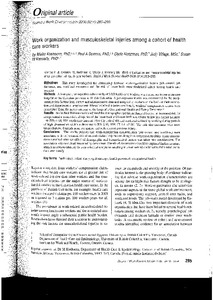Work organization and musculoskeletal injuries among a cohort of health care workers

Koehoorn, Mieke ; Demers, Paul A. ; Hertzman, Clyde ; Village, Judy ; Kennedy, Susan M.
Scandinavian Journal of Work, Environment and Health
2006
32
4
285-293
back disorders ; cohort study ; epidemiologic study ; job satisfaction ; healthcare worker ; musculoskeletal diseases ; occupation disease relation ; occupational risks ; work organization ; work load
Occupational safety and health
English
Bibliogr.;Charts
"Objectives This study investigated the relationship between work-organization factors (job control, job demands, and workload measures) and the risk of lower-body musculoskeletal injury among health care workers.Methods A four-year, retrospective cohort study of 3769 health care workers was carried out in one acute care hospital in the Canadian province of British Columbia. A job-exposure matrix was constructed for the work-organization factors from survey and administrative data and assigned to workers on the basis of their occupation and department of employment. Musculoskeletal injuries resulting in workers' compensation claims were ascertained from the injury database of the hospital's Occupational Health and Safety Department.Results In the final Poisson models adjusted for demographic and biomechanical factors, an increased risk for compensated musculoskeletal injuries of the lower back and lower limb was related to low job control [relative risk (RR) 1.64, 95% confidence interval (95% CI) 1.08–2.49] and workload defined by working during periods of high absenteeism within a department (RR 2.10, 95% CI 1.61–2.98). The risk also increased with more biomechanical demands in an occupation and with a recent previous injury.Conclusions The results indicate that work-organization characteristics (job control and workload) were associated with an increased risk of musculoskeletal injuries resulting in a compensation claim. These associations remained after the effect of demographic and biomechanical factors was taken into consideration. The association with workload measured by departmental levels of absenteeism should be explored further in future studies as reverse causality (musculoskeletal symptoms resulting in absenteeism) could not be fully ruled out in the current study."
Digital
The ETUI is co-funded by the European Union. Views and opinions expressed are however those of the author(s) only and do not necessarily reflect those of the European Union or the ETUI.